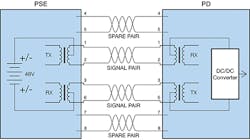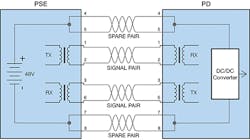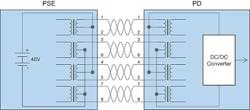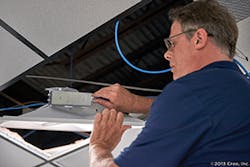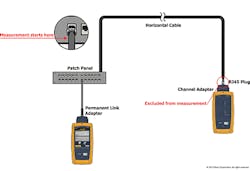Latest from Core/Legacy
4-Pair PoE and Your Cabling Plant —
For several years, you’ve been deploying cable plants that support power over Ethernet (PoE) for a variety of devices like VoIP phones and security cameras. So far, up to 30 Watts is all you’ve been requested to support, but with the plethora of devices now able to take advantage of higher levels of PoE — like the latest 802.11ac Wi-Fi access points, digital displays, and even desktop computers — your customers are starting to ask for 4-pair PoE. This article provides an update on 4 PoE-related topics: the proposed standards, cabling requirements, LP cabling certification, and field-terminated plugs.
The Proposed Standards
Let’s start with the differences between the existing types of PoE. Type 1 PoE delivers up to 15.4 W, with 13 W available for the device, and Type 2 PoE (sometimes referred to as PoE Plus) delivers up to 30 W, with 25.5 W available for the device. Both deliver power over 2 pairs using one of two methods: Alternative A and Alternative B. (See Figure 1.)
Figure 1. Type 1 PoE comes in 2 alternatives.
In Alternative A, power is delivered simultaneously with data over pairs 1-2 and 3-6. In Alternative B, power is delivered over spare pairs 4-5 and 7-8. While Alternative A is compatible with both 2-pair (such as 10/100BASE-T) and 4-pair (such as 1000BASE-T) applications, Alternative B is compatible only with data signals that use 2 pairs.
The proposed 802.3bt standard for 4-pair PoE includes Type 3 and Type 4, both of which now deliver power over all 4 pairs simultaneously with data. Type 3 PoE delivers up to 60W, with 51W available for the device, while Type 4 delivers up to 90W, with 71W available for the device. (See Figure 2.)
Figure 2. 4-Pair Type 3 and Type 4 PoE.
Cabling Requirements
In Type 1 and Type 2 PoE using Alternative A, power is transmitted by applying a common-mode voltage on the 2 pairs — meaning the current is evenly split between the 2 conductors. For this to happen, the DC resistance of each conductor in the pair must be balanced (equal), and any difference is referred to as DC resistance unbalance. Too much unbalance can distort data signals, causing bit errors, retransmits, and even nonfunctioning data links.
Like Type 1 and Type 2 PoE Alternative A, 4-pair Type 3 and Type 4 PoE also deliver power via common-mode voltage, so DC resistance unbalance matters here as well. However, in Type 3 and Type 4, it is no longer just the DC resistance unbalance on each pair you need to worry about. Excessive DC resistance unbalance between multiple pairs can also wreak havoc on data transmission and cause PoE to stop working.
While poor quality cable with variations in conductor diameter and concentricity (roundness) are at a higher risk of DC resistance unbalance, inconsistent terminations where individual conductors are not properly and consistently seated within IDCs can also cause DC resistance unbalance. So, while you may see a DC resistance unbalance specification on a vendor’s cable, field testing is really the only way to ensure DC resistance unbalance performance after installation.
Advanced field test sets are now available that can quickly and easily test DC resistance unbalance within a pair and between pairs, so you can rest assured that the cable plant you deploy will perform in 2- and 4-pair PoE applications.
Heat Rise and Limited Power Cabling
Unfortunately, DC resistance unbalance isn’t the only thing you need to worry about.
When PoE is delivered over twisted-pair copper cabling, increased temperature within the cable can increase insertion loss. This can cause a channel to fail insertion loss testing or require the length of the cable to be reduced.
Heat generated by PoE is even more of an issue when multiple cables delivering PoE are together in a tight bundle — and the higher the power, the greater the heat. The National Electric Code (NEC®) specifies the number of cables allowed in a bundle based on conductor size and temperature rating for 60W or higher PoE. The TIA is also developing guidelines for limiting temperature rise in a bundle.
Following a fact-finding study to investigate the effects of higher levels of PoE applied over cables in a bundle, Underwriter’s Laboratories (UL) introduced a Limited Power (LP) Certification to help simplify cable choice for PoE applications. The LP certification indicates that a cable has been tested to carry PoE under worst-case installation scenarios without exceeding the temperature rating of the cable. The certification accounts for large bundle sizes, high ambient temperatures, and other environmental effects such as enclosed spaces or conduits.
It’s important to understand that LP is a certification, not a listing or a rating. So unlike other UL listings or plenum or riser ratings that are required by the NFPA 70 National Electric Code®, LP-certified cable is an option — not a requirement.
And speaking of the NEC, the 2017 edition contains new requirements that also address the heat rise issue — but only when power is greater than 60W (Type 3). For these cases, NEC includes ampacity tables that specify the maximum ampacity allowed for a certain cable bundle size, conductor gauge and cable temperature rating installed in an ambient temperature of 30°C (86°F). Because the NEC is law, complying with these ampacity tables is required. However, the NEC does allow the use of an LP-certified cable as an alternative to following the ampacity table.
The good news is that you only need to worry about this issue if you’re planning to run PoE above 60W, and most PoE-enabled devices, including LED lights, require less than that.
The bad news is that you never really know how much power might eventually be delivered over the cable, so following ampacity tables or using LP-certified cable is a good method for future proofing. Other options include using cables with larger diameter conductors, higher temperature ratings, or shielded construction, as well as simply choosing to not use cable bundles.
While DC resistance unbalance is not typically an issue in higher quality cables that would have a higher temperature rating or LP certification, poor workmanship can still cause too much resistance unbalance. Therefore, it is still recommended that LP cabling be tested for DC resistance.
Modular Plug Terminated Links
With the Internet of Things (IoT) and the development of sensor technology, more and more devices are becoming IP-enabled and connecting to the copper horizontal cabling infrastructure. Most of these devices such as LED lights, security cameras, building automation controls, and Wi-Fi access points, include an integrated RJ45 port for connecting to the network.
There may be scenarios where a typical 4-connector channel is not used when connecting these types of devices — especially those that reside in the ceiling space where it is impractical to install a faceplate. Instead, there is just 1 patch cord in the telecommunications room and the permanent link is terminated at the other end with a plug, so it can plug directly into the device, essentially eliminating the equipment cord. This creates what is now known as a Modular Plug Terminated Link, or MPTL, and as this application becomes more common and shows up in industry standards, it’s good to get a handle on how to test it today. (See Figure 3.)
Figure 3. Modular Plug Terminated Links are employed in places where an extra patch cord is not convenient.
Some of the benefits of using a plug-terminated link include improved security and aesthetics by avoiding exposed patch cords that can be inadvertently or deliberately disconnected (think of a security camera), and the ability to adhere
to the code requirement of placing only plenum-rated products in air-handling spaces (not all patch cords are plenum-rated).
The use of a link that terminates to a plug and eliminates the equipment cord was first called out in the BICSI 005 Electronic Safety and Security standard, and appears again in the BICSI 033 Information Communication Technology Design and Implementation Practices for Intelligent Buildings and Premises targeted for publication later this year. The TIA-862 Building Automation Standard also recognizes the need to eliminate an equipment cord when deemed unfeasible or unsafe, and specifically allows for the use of a plug-terminated link. This application was originally referred to as a direct attach connection but due to confusion with direct attach connections used in data center switch-to-server applications, the terminology has evolved.
While recognized by industry standards as an application, there were previously no specific test requirements for a plug-terminated link specified by the TIA. Hence, as recommended by BICSI, these connections were originally tested using Modified Single-Connector Permanent Link testing. This was achieved by attaching the main testing unit at the patch panel with a Permanent Link Adapter, attaching the remote unit at the far end with a Channel Adapter, and choosing the "Mod 1-Conn Perm. Link" application on the tester. The problem with using a Channel Adapter at the far end is that the mated connection at the far end was excluded from the test.
With the proliferation of field-terminated plugs, and the potential for a poor plug termination, standards bodies have recognized the need for a test procedure that includes the final plug connection at the far end. The current draft of the ANSI-TIA568.2-D standard includes the MPTL configuration, and this test is already integrated into leading field test systems. (See Figure 4.)
Figure 4. The Modular Plug Terminated Link configuration is tested using a Permanent Link adapter at one end and a Patch Cord adapter at the other end.






